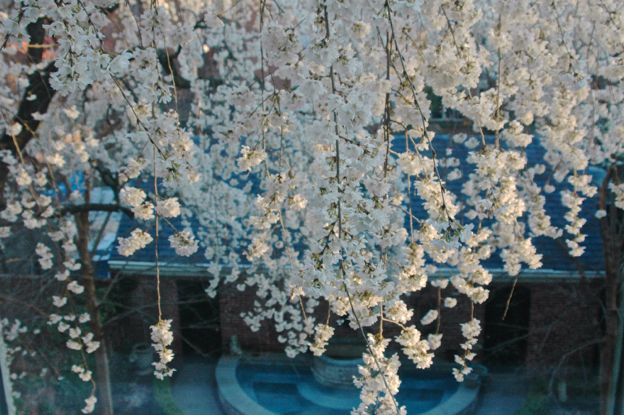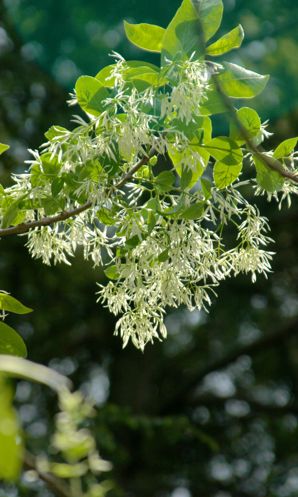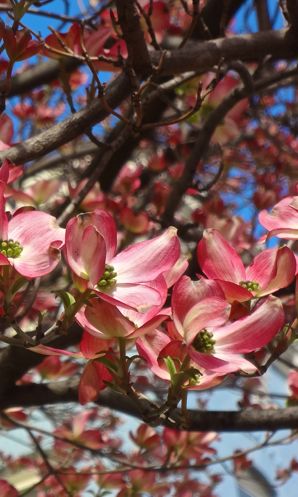The Color Purple


Purple is a great color – regal, royal, romantic, and more. No matter the time of year, whether it is purple kale in winter or purple irises in summer, you can’t go wrong with purple. The exception is when it comes in the form of small ripe cherries splatting down from the cherry tree beside the patio where they smear when walked on, are tracked into the farthest reaches of the house, and are digested and copiously excreted by birds overhead.
The weeping cherry tree on my patio, dazzling for a week every spring -- sweet white petals profusely cascading down its long, pendulous branches -- turns into an unbelievably messy tree by early summer with a malevolence that reminds me of the transition of Dr. Jekyll into Mr. Hyde. It has just finished four weeks of dropping its amaranthine fruity load onto chaise lounges, the white market umbrella, and unsuspecting people. As the hard green cherries began to ripen, squishy fruit and violet-white bird poop rained down vigorously, especially when squirrels and birds were dining. In short order, the flagstone terrace looked like a poor imitation of a Jackson Pollock canvas, and violet splats covered every surface beneath the tree’s benign-looking canopy.
The point is that there are good trees for small gardens and terraces, and there are messy trees for small gardens and terraces. Most complaints about are evergreen magnolias that drop large leathery leaves, mulberry trees that drop large sticky crimson berries, and female ginkgos that drop delicious nuts encased in foul smelling plumy fruits.

And weeping cherry trees. Lately I have been fantasizing about chopping that tree down. After all, if George Washington can do it, then so can I. I would replace it with something beautiful and well behaved. A Golden Rain Tree (Koelreuteria paniculata) might be a good choice. An Asian native, it is a fast growing tree that will reach up to 30-40 tall and wide, but can be pruned to keep it in check. One of its attractions is that it blooms in summer when relatively few other trees are blooming. Panicles of small, bright lemon-colored flowers appear in July and August and morph into clusters of brown seed pods in fall that persist into winter when they provide texture and interest. Its leaves are comprised of small leaflets arranged along a center stalk that become a good yellow-orange in autumn. Golden Rain Trees do self-sow so its seedlings need to be pulled each spring.
A smaller alternative would be the American native, the Fringe Tree, (Chionanthus virginicus), which George Washington actively sought for Mount Vernon. Fringe Trees grow slowly up to 15-20', to it is ideal for a small space. Its flowers are unusual – bouquets of long, fringy white flowers that exude a delicious fragrance -- and appear in late spring. In summer the flowers become loose clusters of blue olive-shaped berries (not toxic) that birds relish and in fall its leaves fade to gold. Fringe Trees are low-maintenance trees prefer that fertile, moist, well drained soil, and will tolerate full sun or part-shade. It is interesting to note that there are male and female trees, though they are not usually labeled as such as hollies often are.

As long as we are talking about native species that George Washington collected, we should mention dogwoods (Cornus florida). It is difficult to think of another species of tree that is more perfect for small gardens than the dogwood. My regular readers know that I prefer trees and shrubs with multi-season interest, and dogwoods fit the bill perfectly. In winter, the black alligator bark stands out sharply against snow and sky and the delicate twigs bear little knobs that turn into large flowers (actually small clusters of flowers with large colored leaves called bracts) in mid-spring. In summer dogwoods produce cheery red berries (non-staining), and in fall their leaves turn deep maroon to cherry red. I find their fall color combined with their bright red fruits just as beautiful as their spring displays. Dogwoods are susceptible to anthracnose, a fungus, but there are several resistant cultivars, both pink and white, available. As is true of all trees, a properly planted dogwood, located in full or part sun with adequate air circulation and in good soil, will thrive.

While evergreen magnolias are too large and messy for small gardens, their native cousin, the semi-evergreen Sweetbay Magnolia (Magnolia virginiana) is a drought-tolerant charmer. I was first introduced to this tree at the National Arboretum and it was love at first sight. I’ve never had a good spot for one, but I managed to persuade a neighbor to plant one once, and I made a point of visiting it (and her) when it was blooming just to drink in the classic magnolia scent from its waxy ivory flowers. The flowers are reminiscent of those the evergreen magnolia but are smaller and appear sporadically from mid-summer to fall instead of having an intense, one-time display like some of its deciduous spring blooming cousins. Sweetbay Magnolias will reach 15-25 feet, developing a pretty rounded shape, and can grow in a variety of soils as long as it doesn’t dry out. Its foliage is semi-evergreen during warm winters and in fall, its red berries, arrayed on cone shaped spikes, are a great food source for mockingbirds, catbirds, bobwhite, and your pet wild turkey.

Chopping down that cherry will give me enough sun for a Crepe Myrtle (Lagerstroemia), native to India and other parts of Asia. Though available in shrub and dwarf forms, I prefer the tree form, especially when they have not been over-pruned into nubs as they too often are. Crepe myrtles seem especially ubiquitous this time of year, so it might be too obvious a choice, but they make excellent specimen trees that meet the multi-season interest test. They do not begin to leaf out until late in spring, but are otherwise splendid the rest of the year. The real show begins in summer when dense bouquet-like clusters of crepe-papery flowers emerge. The flowers last into well into fall, an advantage over trees with shorter bloom times, but that means you must select a color of which you do not tire easily. I would plant a white one, rather than one of the varieties of pink, red, and lavender because white is easier to work with in my garden. Crepe Myrtle leaves are quite small and tidy, and turn radiant shades of orange and red in the fall. In winter, the cinnamon colored bark exfoliates giving it a mottled appearance, and its dark brown seed heads add interest, especially when snow or ice-covered. Mildew can be problematic, so look for a cultivar specifically bred to be mildew resistant like “Hopi” or “Zuni”.
Choosing the right tree for a small garden should not be hard, which makes me wonder who’s bright idea it was to plant that cherry. The trick is, as always, to determine the conditions and size of the space and to work within those parameters. Height, spread, seasonal interest, sunlight requirements, soil conditions – all are important features you should take under consideration when you select a tree. The one thing that is different about trees for small gardens is the messiness factor. A messy tree will make you see red. Or purple of the not regal, royal, or romantic kind.





